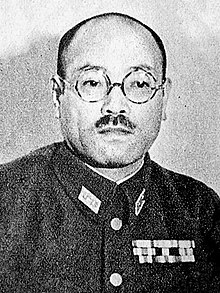Sakai Takashi
Sakai Takashi ( Japanese 酒井 隆 ; born October 18, 1887 in Hara , Kamo-gun (today: Higashihiroshima ), Hiroshima Prefecture ; † September 30, 1946 ) was a Japanese lieutenant general in the Imperial Japanese Army during the Second World War , known for the conquest of Hong Kong in 1941.
biography
He attended military schools in Kobe and Osaka and graduated in the 20th year of the Army Officer's School in 1908 , whereupon he was posted to the 28th Infantry Regiment. He graduated from the 28th year of the Army University . In 1924 he was promoted to major and in 1928 to lieutenant colonel.
Career in China
During the Jinan Incident in 1928, Sakai was stationed in Jinan , Shandong Province , China and is blamed by some Chinese historians for the murder of the Kuomintang envoys during the negotiations on May 4, 1928. From 1929 to 1932, he was transferred to the Tianjin Garrison .
In 1932, Sakai was promoted to colonel and until 1934 assigned to the fifth section of the Military Intelligence Service of the Second Army General Staff Office .
As chief of staff of the Garrison Army of China from 1934 to 1935, Sakai orchestrated a series of armed conflicts that resulted in a ceasefire agreement with the Chinese government that essentially gave Japan control of Hebei province . In 1936 he became the commander of the 23rd Infantry Regiment.
In 1937 Sakai was promoted to major general and appointed commander of the 28th Infantry Brigade. In 1939 he became lieutenant general and until 1940 he was a member of the Mengjiang committee of the Asia Development Group in the coordination office. He was also assigned to the Mongolia Garrison Army at that time .
Recalled to Japan in 1940, Sakai was immediately appointed commander of the Imperial Guard .
Second World War
Sakai was the commander of the 23rd Army stationed in Guangdong in November 1941 . He received orders with the 38th Division , which belonged to the Southern Army , to conquer Hong Kong . He was given a ten day time limit for this assignment. On December 8, 1941, a few hours after the attack on Pearl Harbor , Japanese troops under the command of Sakai invaded Hong Kong. However, the subsequent battle for Hong Kong did not go as quickly or as smoothly as the planners had expected, which is why Sakai formally asked for an extension of the time limit set for him.
Mark Aitchison Young , the British governor of Hong Kong , surrendered and surrendered all British troops in Hong Kong after eighteen days of fighting on December 25, 1941. Sakai's frustration with the unexpectedly strong British resistance may be reflected in the extreme brutality that characterized the operation and the subsequent occupation .
Until February 20, 1942, Sakai served as the governor of Hong Kong. In 1943 he was recalled to Japan and withdrew from active service.
After the war, Sakai was before the military tribunal for crimes against humanity during his time in Hong Kong before a military tribunal in Nanjing accused and sentenced to death . He was shot dead on September 30, 1946 .
Web links
- Sakai's method before ICTY (English)
- Takashi Sakai in the Pacific War Online Encyclopedia (English)
Individual evidence
- ↑ Steen Ammentorp: The Generals of WWII - Sakai Takashi. In: www.generals.dk. Retrieved February 5, 2009 .
- ^ Kent G. Budge: The Pacific War Online Encyclopedia. In: http://pwencycl.kgbudge.com . Retrieved February 5, 2009 .
| personal data | |
|---|---|
| SURNAME | Sakai Takashi |
| ALTERNATIVE NAMES | 酒井 隆 (Japanese) |
| BRIEF DESCRIPTION | Japanese lieutenant general |
| DATE OF BIRTH | October 18, 1887 |
| PLACE OF BIRTH | Hara , Kamo-gun (now: Higashihiroshima ), Hiroshima Prefecture |
| DATE OF DEATH | September 30, 1946 |
